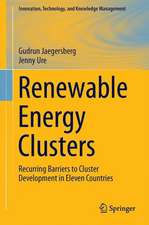Modeling and Control in Air-conditioning Systems: Energy and Environment Research in China
Autor Ye Yao, Yuebin Yuen Limba Engleză Hardback – 12 oct 2016
Subsequently, virtual sensor calibration and virtual sensing methods (which are very useful for real system control) are illustrated together with a case study. Model-based predictive control and state-space feedback control are applied to air-conditioning systems to yield better local control, while the air-side synergic control scheme and a global optimization strategy based on the decomposition-coordination method are developed so as to achieve energy conservation in the central air-conditioning system. Lastly, control strategies for VAV systems including total air volume control and trim & response static pressure control are investigated in practice.
| Toate formatele și edițiile | Preț | Express |
|---|---|---|
| Paperback (1) | 954.31 lei 6-8 săpt. | |
| Springer Berlin, Heidelberg – 16 iun 2018 | 954.31 lei 6-8 săpt. | |
| Hardback (1) | 960.42 lei 6-8 săpt. | |
| Springer Berlin, Heidelberg – 12 oct 2016 | 960.42 lei 6-8 săpt. |
Preț: 960.42 lei
Preț vechi: 1171.25 lei
-18% Nou
Puncte Express: 1441
Preț estimativ în valută:
183.77€ • 192.57$ • 151.92£
183.77€ • 192.57$ • 151.92£
Carte tipărită la comandă
Livrare economică 11-25 aprilie
Preluare comenzi: 021 569.72.76
Specificații
ISBN-13: 9783662533116
ISBN-10: 3662533111
Pagini: 450
Ilustrații: XXI, 479 p. 272 illus., 46 illus. in color.
Dimensiuni: 155 x 235 x 27 mm
Greutate: 0.88 kg
Ediția:1st ed. 2017
Editura: Springer Berlin, Heidelberg
Colecția Springer
Seria Energy and Environment Research in China
Locul publicării:Berlin, Heidelberg, Germany
ISBN-10: 3662533111
Pagini: 450
Ilustrații: XXI, 479 p. 272 illus., 46 illus. in color.
Dimensiuni: 155 x 235 x 27 mm
Greutate: 0.88 kg
Ediția:1st ed. 2017
Editura: Springer Berlin, Heidelberg
Colecția Springer
Seria Energy and Environment Research in China
Locul publicării:Berlin, Heidelberg, Germany
Cuprins
Introduction.- State-space modelling for air-conditioning system.- Modelling based on graph theory and structure-matrix theory.- Control design based on state-space model.- Air-conditioning load forecasting model.- Optimal operation and energy analysis modelling for air-conditioning system.- Thermal comfort of human body indoors.- Multizone network modelling of building ventilation and contaminant transport.- Computational fluid dynamics of building environment.- Coupled multizone and CFD modelling of building environment.- New trends of advanced modelling of building environment.
Textul de pe ultima copertă
This book investigates the latest modeling and control technologies in the context of air-conditioning systems. Firstly, it introduces the state-space method for developing dynamic models of all components in a central air-conditioning system. The models are primarily nonlinear and based on the fundamental principle of energy and mass conservation, and are transformed into state-space form through linearization. The book goes on to describe and discuss the state-space models with the help of graph theory and the structure-matrix theory.
Subsequently, virtual sensor calibration and virtual sensing methods (which are very useful for real system control) are illustrated together with a case study. Model-based predictive control and state-space feedback control are applied to air-conditioning systems to yield betterlocal control, while the air-side synergic control scheme and a global optimization strategy based on the decomposition-coordination method are developed so as to achieve energy conservation in the central air-conditioning system. Lastly, control strategies for VAV systems including total air volume control and trim & response static pressure control are investigated in practice.
Subsequently, virtual sensor calibration and virtual sensing methods (which are very useful for real system control) are illustrated together with a case study. Model-based predictive control and state-space feedback control are applied to air-conditioning systems to yield betterlocal control, while the air-side synergic control scheme and a global optimization strategy based on the decomposition-coordination method are developed so as to achieve energy conservation in the central air-conditioning system. Lastly, control strategies for VAV systems including total air volume control and trim & response static pressure control are investigated in practice.
Caracteristici
Includes many advanced modeling methods in the field of heating, ventilation, air conditioning and refrigeration (HVAC & R) and building environments Offers a detailed introduction to HVAC systems and building environments Makes a significant contribution to the development of energy-saving technologies in air-conditioning systems and buildings Includes supplementary material: sn.pub/extras

































